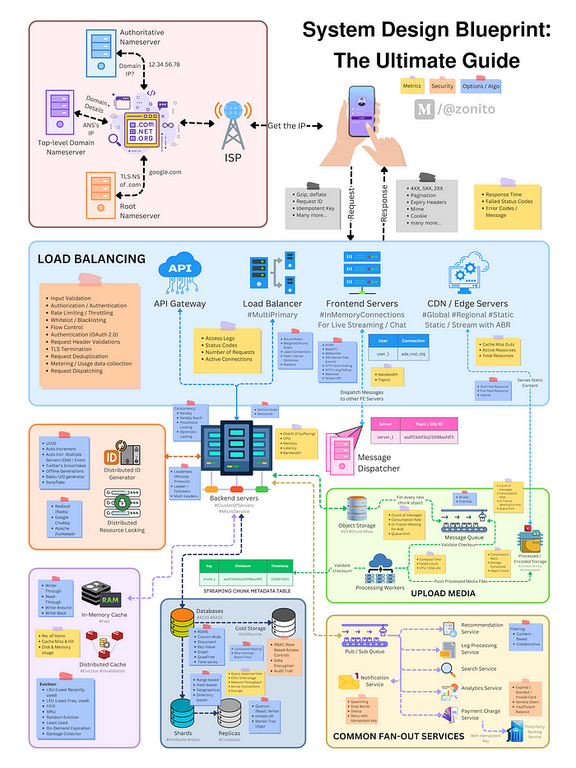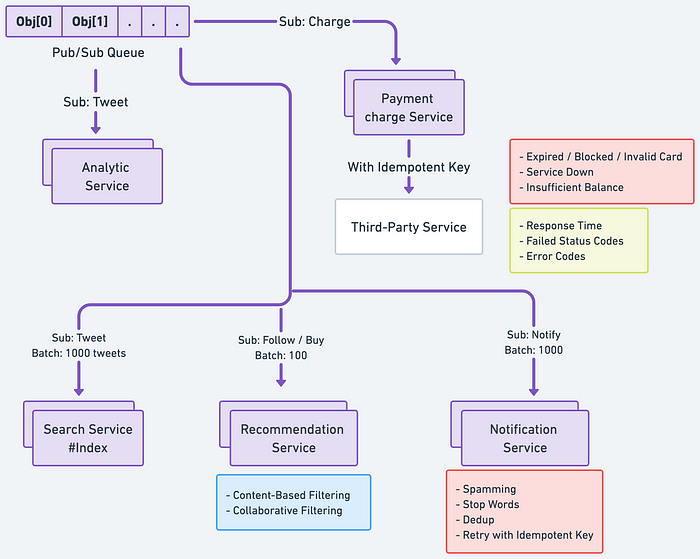
Building a system that is not only robust and scalable but also efficient, may seem like an overwhelming endeavor at first glance. However, by grasping the fundamental concepts and elements involved, you can break down the complexity and tackle the process more masterfully. In this exploration, we will delve into the pivotal components of system design—ranging from DNS and load balancing to API Gateway—and provide a handy cheat sheet for developers tasked with crafting systems of varying intricacies.
The System Design Roadmap
Imagine a comprehensive visual guide at your disposal, offering quick reference to the foundational principles and recommended practices in system design. Envision a blueprint that navigates you through the vast landscape of DNS, load balancing, API Gateway, and beyond—covering video and image handling, caching, databases, unique ID creation, and common components like payment services and recommendation engines, as well as chat and streaming protocols. This valuable tool ensures you are well-prepared to meet the challenges of designing scalable and reliable systems.

Download the full resolution guide: The Ultimate System Design Blueprint
Foundational Pillars of System Design
1. Modularization: Breaking Down the Complex
By segmenting the system into smaller, more digestible modules, you simplify complexity, enhance maintainability, and boost reusability.
2. Abstraction: Focusing on the Core
Abstraction involves masking the intricacies of implementation, thereby presenting only the crucial features and simplifying the system. This elevation of focus aids in promoting modularity.
3. Layering: The Art of Organization
Layering structures a system into functional tiers, with each one offering distinct functionalities. This promotes a separation of concerns and fortifies the system’s maintainability.
4. Scalability as a Cornerstone
Design systems to gracefully expand under increased demand, either by scaling horizontally with added resources or by optimizing the system’s current capacity.
5. Performance: Efficiency as a Competitive Edge
Prioritize optimizing the system’s response times, throughput, and resource consumption—crucial elements for designing successful systems.
6. Security: The Watchguard of Integrity
Ensure confidentiality, integrity, and availability by implementing robust security practices, safeguarding your system against potential vulnerabilities.
7. Fault Tolerance and Resilience: Endurance Under Pressure
Craft systems to withstand failures gracefully and recover effectively, maintaining reliability and availability under various circumstances.
Core Elements of System Design
1. DNS: The Digital Map
DNS operates as a hierarchical and decentralized naming system, translating user-friendly domain names into numerical IP addresses, facilitating efficient access to websites and services. Read More

2. Load Balancing: The Traffic Conductor
Distribute network traffic across various servers to prevent any single server from becoming overwhelmed, thereby enhancing system reliability and performance. Common load balancing algorithms include Round Robin and Least Connections. Explore the Cheatsheet
3. API Gateway: The Interface Manager
An API Gateway serves as the intermediary between clients and microservices, directing requests, enforcing security protocols, and providing additional services like caching and logging.
4. CDN: The Global Distributor
Content Delivery Networks reduce latency by distributing server loads through a network of globally distributed servers. CDNs cache content closer to users, enhancing system performance and reducing origin server load. Read More with Cheatsheet
5. Message Queue: The Decoupling Master
Message queues allow separate components to communicate asynchronously, storing messages in transit and boosting system scalability and resilience. Discover More
6. Communication Protocols: Bridging Gaps
Various protocols, such as HTTP/HTTPS, WebSocket, and gRPC, play roles in system design. Your selection will depend on attributes like latency, security, and data transfer requirements.
7. Cache: Accelerating Efficiency
Caching temporarily stores data copies for speedier retrieval on subsequent requests, effectively reducing latencies, server burdens, and bandwidth usage. Popular caching methodologies include in-memory and distributed caching. Explore More with Cheatsheet.
8. Database: Choosing the Foundation
Different data structures, scalability needs, and consistency considerations necessitate diverse database solutions—ranging from relational databases to NoSQL and NewSQL options.
9. Replication Techniques: Ensuring Continuity
Replication involves maintaining multiple data copies, boosting system reliability, availability, and fault tolerance through techniques like synchronous and asynchronous replications.
10. Distributed Unique ID Generation: Conquering Uniqueness
Generating unique identifiers within a distributed system anchors data consistency and integrity. Learn More with a Comparison Table
Advanced Handling of Large Media Uploads
Streamlining with Signed URLs
Signed URLs, embedded with authentication signatures, offer temporary and secure access to specific resources, facilitating actions like file uploads or downloads.
Optimizing Through Chunked Uploads
Chunking large files for upload can drastically enhance efficiency and reduce failure risks due to network inconsistency.
Integrating Signed URLs with Chunked Uploads
- Segmentation: Divide the file into smaller, more manageable chunks, optimizing based on network conditions.
- Authorization: Obtain signed URLs for each chunk from the server, embedding necessary permissions.
- Sequential or Concurrent Uploads: Utilize the signed URLs to upload each chunk, aligned with your network strategy.
- Final Verification: Upon successful upload of all chunks, notify the server for final reassembly.
- Error Management: Strategize redundancy with error handling and retry mechanisms for any failed transfers.
Real-Time Interaction Through Chat and Streaming Protocols
RTMP: Real-Time Streaming Pioneer
This protocol facilitates low-latency streaming despite its decline following Flash Player’s fade.
WebRTC: Bridging Real-Time Communications
WebRTC underpins open-source, real-time communication in web realms, directly linking peer-to-peer connections.
WebSocket: Symbiotic Client-Server Link
Facilitating low-latency, bidirectional data flow for real-time applications, WebSocket connects client and server in a lasting relationship.
SSE: The Asynchronous Update
Facilitate server-to-client updates over HTTP, perfect for live updates and notifications.
HTTP Strategies: Polling Tactics
Implement short polling for simple checks or long polling for reduced server load and latency, depending on application demands.
Webhooks: Event-Driven Efficiency
User-defined HTTP callbacks ignite upon specific system events, streamlining cross-system communication.
Essential System Design Components
1. Payment Service
Manage transactions securely and reliably with APIs from leading providers such as Stripe and PayPal, essential for e-commerce platforms.
2. Analytics
Gain insights through real-time data collection and visualization—tools like Google Analytics can empower business strategies.
3. Notification Engines
Keep users in the loop through email, SMS, and push services—strategically informing with services like Firebase Cloud Messaging.
4. Search Capabilities
Embed swift and scalable searches, navigating vast data landscapes through solutions like Elasticsearch.
5. Recommendation Engines
Enhance user engagement through algorithms that predict preferences—fostered through collaborative filtering or advanced machine learning.

Mastering the System Design Process
1. Requirement Gathering
Clear comprehension of system needs is crucial pre-design.
2. Embrace Design Patterns
Employ reliable patterns that resolve standard design challenges, enhancing system architecture.
3. Maintain Thorough Documentation
Comprehensively document to fortify communication and sustain future maintenance.
4. Iterative Design Enhancements
Iteratively refine designs, incorporating feedback continually for enhanced solutions.
5. Focused Testing and Evaluation
Ensure designs meet requirements through rigorous validation and testing.
Conclusion: A Continuing Odyssey
System design is a multidimensional and intricate art that beckons an earnest understanding of diverse components, protocols, and strategies. Through this article, we’ve navigated essential elements like DNS, load balancing, API Gateway, media handling, caching, databases, ID generation, and essential components including payment services. This insight empowers developers to forge systems that are not only scalable and efficient but also reliably cater to diverse user demands.
Remember, system design thrives on iteration—continuous adaptability and refinements keep systems resilient. By focusing on these foundational concepts and nurturing flexibility, developers can confidently manage the challenges of crafting robust, high-performing systems for the ever-evolving digital landscape.






